
Looking for How to make and can homemade enchilada sauce from fresh tomatoes - easy and illustrated! in 2025? Scroll down this page and follow the links. And if you bring home some fruit or vegetables and want to can, freeze, make jam, salsa or pickles, see this page for simple, reliable, illustrated canning, freezing or preserving directions. There are plenty of other related resources, click on the resources dropdown above. If you are having a hard time finding canning lids, I've used these, and they're a great price & ship in 2 days.
If you have questions or feedback, please let me know! There are affiliate links on this page. Read our disclosure policy to learn more.
How to make and can homemade enchilada sauce from fresh tomatoes - easy and illustrated!
How to make and can homemade enchilada sauce from fresh tomatoes!
Pressure Canner Recipe
Click here for a PDF print version!
Making and canning your own enchilada sauce is something families remember years later. No store bought enchilada sauce compares with the taste of that made from your own tomatoes from your garden or fresh-picked from a local farm! In the middle of the winter, you can make a meal with your enchilada sauce and taste the summer flavor of fresh tomatoes. This recipe is for enchilada sauce WITHOUT meat, so you can use a water bath canner or a Pressure Canner.
Pressure canners work better for tomatoes and other low acid foods - you will get less spoilage with a Pressure Canner.
I prefer a Pressure Canner (see photo below) . To order one, click on Canning supplies and select the canner that is right for your stove (regular or flat bottomed for glass or ceramic stoves)
Here's how to do it, in easy steps and completely illustrated. This method is so easy, ANYONE can do this! It's a great thing to do with your kids! For a Taco sauce recipe, see this page!
I've added free labels for your jars here, in a Word format! Just download, edit, and print in label paper.
Ingredients
Yield: 7 pints
- Tomatoes - 6 cups diced - which means you will need about 10 lbs (by the time you remove the skins, seeds and excess water, it reduces the volume.)
- 12 dried New Mexican Chile peppers - Available at most grocery stores in the Hispanic foods area.
- 2 cups boiling water
- 4 garlic cloves, minced (that's about 4 teaspoons of prepared minced garlic)
- 1 Tablespoons olive oil
- 5 cups coarsely chopped onion (about 4 large onions)
- 1⁄2 cup firmly packed dark brown sugar (if you are on a sugar-restricted or reduced carb/calorie diet, you could use an equivalent amount of Stevia, like 1/2 cup Truvia)
- 2 Tablespoons chili powder
- 2 teaspoons salt
- 2 teaspoons ground cumin
- 1 teaspoons ground red pepper (plain red, cayenne, paprika or chipotle)
Equipment
- 1 Pressure Canner Note: we sell many sizes and types of canners for all types of stoves and needs - see canning supplies). Tomatoes are on the border between the high-acid fruits that can be preserved in a boiling-water bath and the low-acid fruits, vegetables and meats that need pressure canning
- Pint canning jars (Ball or Kerr jars can be found at Publix, Kroger, Safeway and local "big box" stores - about $13 per dozen 8-ounce jars, more for quilted design or larger jars, including the lids and rings). Pint size works best, but quarts are allowed, too, since the pressure canner will thoroughly heat them.!
- Lids - thin, flat, round metal lids with a gum binder that seals them against the top of the jar. They may only be used once. Lids are getting very hard to find in the stores. See this page for good lids you can get online.
- Rings - metal bands that secure the lids to the jars. They may be reused many times.
- Jar grabber (to pick up the hot jars out of the canner)
- Lid lifter (I like the lid rack that holds 12 lids or you can pull them out one at a time with the lid-lifter that has a magnet from the almost-boiling water where you sanitize them. ($4 at mall kitchen stores and local "big box" stores, but it's usually cheaper online from our affiliates)
- 1 large pot.
- Large spoons and ladles,
- Jar funnel ($3-Grocery stores, like Publix, Kroger and Safeway and local "big box" stores; sometimes even hardware stores)
Process - How to Make Enchilada Sauce from Fresh Tomatoes
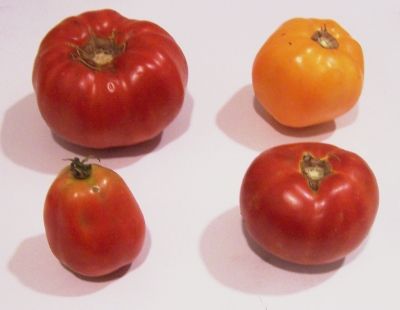 Step 1 - Selecting the
tomatoes
Step 1 - Selecting the
tomatoes
It's fun to go pick your own and you can obviously get better quality tomatoes!
At right is a picture of tomatoes from my garden - they are so much better than anything from the grocery store. And if you don't have enough, a pick-your-own farm is the pace to go! At right are 4 common varieties that will work:
| Top left: Beefsteak | Top right: Lemon Boy, yellow |
| Bottom left: Roma, paste-type | Bottom right: Better Boy |
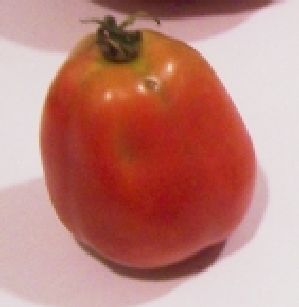 The
picture at right shows the best variety of tomato to use: Roma; also called
paste tomatoes.
They have fewer sides, thicker, meatier walls, and
less water.
And that means thicker sauce in less cooking time!
The
picture at right shows the best variety of tomato to use: Roma; also called
paste tomatoes.
They have fewer sides, thicker, meatier walls, and
less water.
And that means thicker sauce in less cooking time!
Also, you don't want mushy, bruised or rotten tomatoes!
Step 2 - Get the jars and lids sanitizing
 The dishwasher is fine for the jars; especially if it has a "sanitize" cycle.
I get that going while I'm preparing everything else, so it's done by the
time I'm ready to fill the jars.
The dishwasher is fine for the jars; especially if it has a "sanitize" cycle.
I get that going while I'm preparing everything else, so it's done by the
time I'm ready to fill the jars.
Be sure to let it go through the rinse cycle to get rid of any soap!
Lids:
Put the very hot (but not quite boiling; around 180 F, steaming water is fine)
water for at least
several minutes.
Note: everything gets
sanitized in the water
bath (step 7)
anyway, so this just helps to ensure
there is no spoilage later!)
Step 3 - Rinse the tomatoes
Just rinse them in a colander or bowl under cool running water
Step 4 - Dice the tomatoes
Step 5 - Rinse the dried peppers
Dried peppers often have a bit of dirt and debris in them. Just rinse them in a sieve or bowl of running water
Step 6 - Toast, shred and soften the dried peppers
Toast peppers on a very hot fry pan, skillet or griddle. They just need 8 to 10 seconds on each side (until they just start to puff and blister). This brings out their characteristic flavor. But be careful not to burn them or they will become bitter.)
Let them cool, then remove and discard then stems and seeds. Then tear them into large pieces and place in a bowl. Cover with boiling water. Let stand 20 minutes or until softened. Drain, reserving 1 cup soaking liquid.
Step 7 - Sauté the garlic and onions
- Sauté garlic in hot oil in a 6-qt. pot over medium-high heat 30 seconds.
- Stir in onion.
- Cover and cook, stirring often, 10 minutes or until onion is tender.
- Uncover and cook, stirring often, 5 to 10 minutes or until onions are caramel colored.
Step 8 - Add the tomatoes and remaining ingredients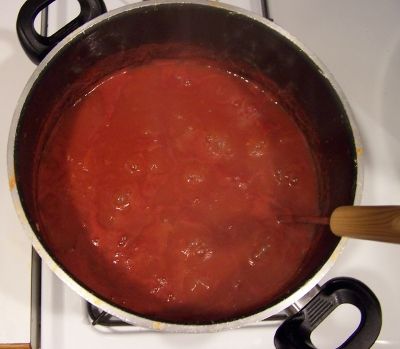
Stir in tomatoes, and the
- 1⁄2 cup firmly packed dark brown sugar (if you are on a sugar-restricted or reduced carb/calorie diet, you could use an equivalent amount of Stevia, like 1/2 cup Truvia)
- 2 Tablespoons chili powder
- 2 teaspoons salt
- 2 teaspoons ground cumin
- 1 teaspoons ground red pepper (plain red, cayenne, paprika or chipotle)
Add the softened chiles, and the reserved soaking liquid.
Remove from heat.
Step 9 - Puree in a blender
Process the mixture, in 2 cup batches, in a blender until smooth.
The put the pureed mixture back in the bot and bring to a boil.
Step 10 - Simmer
Reduce heat, and simmer, uncovered, stirring often for 25 minutes or until the sauce is thick and darkens in color. (As sauce thickens, use a splatter screen or put the lid to partially on (to let the steam out) the pot to avoid splatters.)
Step 11 - Fill the jars with sauce and put the lid and rings on
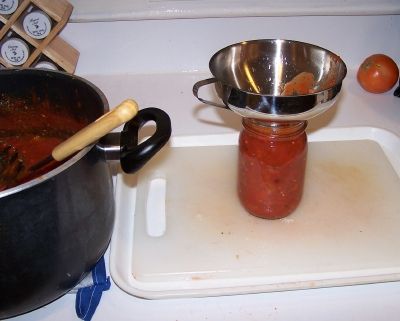 Fill them to within 1/4-inch of the top,
seat the lid and hand-tighten the ring around them.
Fill them to within 1/4-inch of the top,
seat the lid and hand-tighten the ring around them.
NOTE: if you want to freeze the sauce instead, just fill your freezer containers (I like Ziploc freezer bags in the quart size), fill them completely, eliminate air pockets, seal them and pop them in the freezer. You're done!
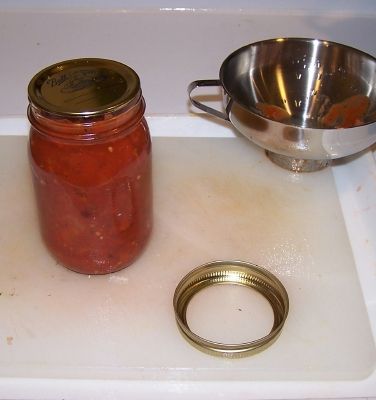 Be sure the contact surfaces (top of the jar
and underside of the ring) are clean to get a good seal!
Be sure the contact surfaces (top of the jar
and underside of the ring) are clean to get a good seal!
Step 12 - Process the jars in the pressure canner
Put them in the canner, get the lid on and start the venting timing. If you haven't used your pressure canner in a while, see our refresher directions about pressure canning.
 Process the sauce
for the time in the tables below, as appropriate for your altitude, jar size and type of canner.
Process the sauce
for the time in the tables below, as appropriate for your altitude, jar size and type of canner.
| Table 1. Recommended process time for enchilada sauce in a dial-gauge pressure canner. | ||||||
| Canner Gauge Pressure (PSI) at Altitudes of | ||||||
| Style of Pack | Jar Size | Process Time | 0 - 2,000 ft | 2,001 - 4,000 ft | 4,001 - 6,000 ft | 6,001 - 8,000 ft |
| Hot | Pints | 50 min | 11 lb | 12 lb | 13 lb | 14 lb |
| Quarts | 55 | 11 | 12 | 13 | 14 | |
| Table 2. Recommended process time for enchilada sauce in a weighted-gauge pressure canner. | ||||
| Canner Gauge Pressure (PSI) at Altitudes of | ||||
| Style of Pack | Jar Size | Process Time | 0 - 1,000 ft | Above 1,000 ft |
| Hot | Pints | 50 min | 10 lb | 15 lb |
| Quarts | 55 | 10 | 15 | |
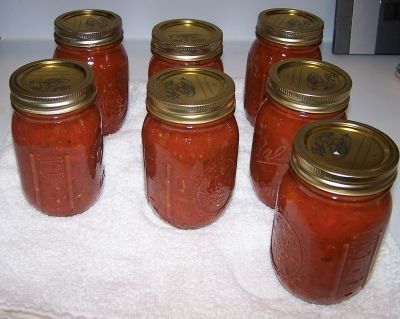
Step 13 - Cooling
- After processing, turn off heat; and allow the canner to cool by itself to zero pressure.
- Let stand 5 more minutes before removing lid.
- Then cool jars in canner for 10 minutes.
- Lift the jars out of the water and let them cool without touching or bumping them in a draft-free place (usually takes overnight)
You can then remove the rings if you like, but if you leave them on, at least loosen them quite a bit, so they don't rust in place due to trapped moisture. Once the jars are cool, you can check that they are sealed verifying that the lid has been sucked down. Just press in the center, gently, with your finger. If it pops up and down (often making a popping sound), it is not sealed. If you put the jar in the refrigerator right away, you can still use it. Some people replace the lid and reprocess the jar, then that's a bit iffy. If you heat the contents back up, re-jar them (with a new lid) and the full time in the canner, it's usually ok.
Frequently Asked Questions about making tomato sauces - Click here
Q. How can I make enchilada sauce to freeze, instead of can?
A. Easy. Just make the canned sauce as shown above, but instead of canning it, stop after step 8 ,
let it cool to room temperature, fill the Ziploc bags and freeze it instead!
Q. Can I add olive oil or any other oil to the recipe?
A. No, both Ball and the USDA warn that their research shows that adding oil to home canning recipes increases the risk of botulism. If you like the taste oil oil, add it after you open the jars when you go to use them!
Other Equipment:
| From left to right: | |
| 1. Jar lifting tongs
to pick up hot jars |
 |
| 2. Lid lifter
- to remove lids from the pot of boiling water (sterilizing ) |
|
| 3. Lid
- disposable - you may only use them once |
|
| 4. Ring
- holds the lids on the jar until after the jars cool - then you remove them, save them and reuse them |
|
| 5. Canning Jar funnel - to fill the jars |
| Find this item (B0001UZL8A) on Amazon |
Home Canning KitsThis is the same type of
standard canner that my grandmother
used to make everything from applesauce to jams and jellies to tomato and
enchilada sauce. This complete kit includes everything you need and
lasts for years: the canner, jar rack, Jar grabber tongs,
lid lifting wand, a plastic funnel,
labels, bubble freer, and the bible of canning, the Ball Blue Book. It's
much cheaper than buying the items separately. You will never need anything else except jars & lids! To see more canners, of different styles, makes and prices, click here!For more information
and current pricing: |
Summary - Cost of Making Homemade enchilada sauce - makes 7 pint jars, 16 oz each* |
||||
| Item | Quantity | Cost in 2021 | Source | Subtotal |
| Tomatoes | 10 lbs (to make about 7 pints) | free from the garden, or $0.50 cents at a PYO | Garden | $0.00 |
| Canning jars (pint size, wide mouth), includes lids and rings | 7 jars | $8.00/dozen | Grocery stores, like Publix, Kroger and Safeway and local "big box" stores; sometimes Big Lots and even hardware stores | $4.50 |
| Misc seasonings | See ingredients | $2.00? | Grocery stores, like Publix, Kroger and Safeway and local "big box" stores | $2.50 |
| Onions | $2.00 | |||
| Minced garlic | $1.00 | |||
| Dried peppers | $3.00 | |||
| Total | $13.00 total or about $1.85 per jar INCLUDING the jars - which you can reuse! |
|||
|
* - This assumes you already have the pots, pans, ladles,, and reusable equipment. Note that you can reuse the jars! Many products are sold in jars that will take the lids and rings for canning. For example, Classico Spaghetti sauce is in quart sized jars that work with Ball and Kerr lids and rings. Note that the Classico's manufacturer does not recommend reuse of their jars: see what they have to say on this page: |
||||
Answers to Common Questions
What did I do wrong if my jars spoil?
Tomatoes are a borderline acid / low acid fruit (see this page about tomato acidity for more information) - adding lemon juice helps, processing at least 35 minutes in the water bath canner, or better still, using a Pressure Canner almost eliminates spoilage. If you don't have a pressure canner, you must boost the acid level of the sauce, by adding 2 tablespoons of lemon juice or 1/2 teaspoon of citric acid per quart of sauce.
The question everyone asks: Can you add meat?
With a water bath canner, absolutely, definitely NOT. The temperatures do not get high enough to kill the type of bacteria that can attack meat and make you sick, or even kill you. However, with a Pressure Canner, it IS possible. I have complete directions here! I don't do it, simply because... have you ever tasted canned meat? Yes, it is called SPAM. My recommendation is to can without the meat and add fresh browned ground meat or meatballs when you use the sauce!
Meat, Part 2 - I noticed you said it is best not to put meat in the sauce, as it might spoil as a child my mom canned all her meat with nothing but salt in it as she had no freezer. I cannot remember a problem with it going bad. She submerged the jars in a canning pot with a wire rack under it and boiled it for 4 hours always making sure the meat in the jar was covered with water so it would not spoil, also the jars kept covered with water at all times for four hours of boiling. "
It is statistically possible to engage in a very dangerous activity and still experience no harm. For example, one of my father's friends charged the beach at Iwo Jima in World War 2, (definitely, one of the riskiest things you could do) and yet he survived without a scratch, while 7 of 10 of his platoon died. Canning meat in a water bath is the same.
The problem is that Botulism is not killed by temperatures under 240. Water baths only reach 212. You could boil it for 4 days and the botulism would still survive. By the time you ate the jars, enough may not have grow to make you ill. But it is still very, very dangerous.
I could send you dozens and dozens of statements supporting what I stated above from many universities and food authorities. Here is one example from the University of Maine:
Match the canner to the food
There are two types of home canning methods: boiling-water-bath canners and pressure canners. The type of canner that you use should be based upon the type of food you are preserving. According to UMaine Food ScienceSpecialist Beth Calder, fruits, pickled foods, sauerkraut, marmalades, fruit spreads, jams, jellies, fruit butters (except for pumpkin) and salsa can be safely preserved using the water-bath canning method. "However, make sure you use a scientifically tested recipe from a reputable resource," she says.
All other foods should be preserved using a pressure canner. This is because botulism-producing bacteria produce spores that can survive boiling water temperatures, but are destroyed using a pressure canner with the appropriate time and pressure, which reaches temperatures between 240 and 250 degrees F.
I have read in other homemade enchilada sauce recipes that you need to cook the mixture for at least 4-5 hours. Is this necessary?
I suppose if you really want to make sure that absolutely no vitamins
survive, you could cook it that long! :) The only reason people used to tomato
sauce that long was the Roma paste-type tomatoes, with thicker walls, meatier
with fewer seeds and less water didn't exist, so they had to cook it for hours
to get rid of water and thicken it. And of course, modern sauce mixes that
contain a little bit of corn starch as a thickener, also help shorten the time.
And for those who want to go strictly organic and au naturale, my method of
squeezing out the excess water and seeds eliminates much of the excess juice
(which you can save as tomato juice for drinking) and lets you start with a
thicker tomato pulp which means much shorter cooking time!
Illustrated Canning, Freezing, Jam Instructions and Recipes
[ Easy Home Canning Directions] [FAQs - Answers to common questions and problems] [Recommended books about home canning, jam making, drying and preserving!] [Free canning publications
Looking for canning equipment and supplies?
Water bath canner with a jar rack
Pressure canners for gas, electric and induction stoves: Presto 23Qt or T-fal 22Qt
Canning scoop (this one is PERFECT)
Ball Blue book (most recent version)
Jars: 8oz canning jars for jams
Find Other types of farms:
Farm markets and roadside stands
Road trips and camping resources
Local Honey, apiaries, beekeepers
Consumer fraud and scams information
Home canning supplies at the best prices on the internet!
Maple Syrup Farms, sugarworks, maple syrup festivals
Environmental information and resources
Farms For Your Event for birthday parties, weddings, receptions, business meetings, retreats, etc.
Festivals - local fruit and vegetable festivals
Get the
most recent version of
the Ball Blue Book
With this Presto 23 quart pressure canner and pressure cooker, you can "can" everything, fruits, vegetables, jams, jellies, salsa, applesauce, pickles, even meats, soups, stews. Model 01781

You can make jams, jellies, can fruit, applesauce, salsa and pickles with water bath canners, like this Granite Ware 12-Piece Canner Kit, Jar Rack, Blancher, Colander and 5 piece Canning Tool Set

